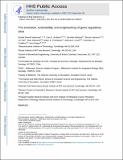The evolution, evolvability and engineering of gene regulatory DNA
Author(s)
Vaishnav, Eeshit Dhaval; de Boer, Carl G; Molinet, Jennifer; Yassour, Moran; Fan, Lin; Adiconis, Xian; Thompson, Dawn A; Levin, Joshua Z; Cubillos, Francisco A; Regev, Aviv; ... Show more Show less
DownloadAccepted version (1.758Mb)
Open Access Policy
Open Access Policy
Creative Commons Attribution-Noncommercial-Share Alike
Terms of use
Metadata
Show full item recordAbstract
Mutations in non-coding regulatory DNA sequences can alter gene expression, organismal phenotype and fitness1-3. Constructing complete fitness landscapes, in which DNA sequences are mapped to fitness, is a long-standing goal in biology, but has remained elusive because it is challenging to generalize reliably to vast sequence spaces4-6. Here we build sequence-to-expression models that capture fitness landscapes and use them to decipher principles of regulatory evolution. Using millions of randomly sampled promoter DNA sequences and their measured expression levels in the yeast Saccharomyces cerevisiae, we learn deep neural network models that generalize with excellent prediction performance, and enable sequence design for expression engineering. Using our models, we study expression divergence under genetic drift and strong-selection weak-mutation regimes to find that regulatory evolution is rapid and subject to diminishing returns epistasis; that conflicting expression objectives in different environments constrain expression adaptation; and that stabilizing selection on gene expression leads to the moderation of regulatory complexity. We present an approach for using such models to detect signatures of selection on expression from natural variation in regulatory sequences and use it to discover an instance of convergent regulatory evolution. We assess mutational robustness, finding that regulatory mutation effect sizes follow a power law, characterize regulatory evolvability, visualize promoter fitness landscapes, discover evolvability archetypes and illustrate the mutational robustness of natural regulatory sequence populations. Our work provides a general framework for designing regulatory sequences and addressing fundamental questions in regulatory evolution.
Date issued
2022Department
Massachusetts Institute of Technology. Department of BiologyJournal
Nature
Publisher
Springer Science and Business Media LLC
Citation
Vaishnav, Eeshit Dhaval, de Boer, Carl G, Molinet, Jennifer, Yassour, Moran, Fan, Lin et al. 2022. "The evolution, evolvability and engineering of gene regulatory DNA." Nature, 603 (7901).
Version: Author's final manuscript